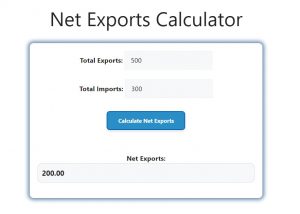About Net Exports Calculator (Formula)
The Net Exports Calculator is a useful tool for analyzing a country’s trade performance. It calculates net exports, which is the difference between total exports and total imports. This metric is crucial for understanding a nation’s economic health, as it reflects the balance of trade. A positive net export value indicates a trade surplus, while a negative value suggests a trade deficit. By using this calculator, individuals and businesses can gain valuable insights into economic trends and make informed decisions based on trade data.
Formula
The formula for calculating Net Exports is:
Net Exports (NE) = Total Exports (E) – Total Imports (I)
Where:
- NE is the Net Exports.
- E is the Total Exports.
- I is the Total Imports.
How to Use
- Gather Data: Collect the total values of exports and imports for the specific period you want to analyze.
- Input Values: Enter the total exports (E) and total imports (I) into the Net Exports Calculator.
- Calculate: The calculator will compute the net exports using the formula provided.
- Analyze Results: Review the output to understand your trade balance, whether it’s a surplus or deficit.
Example
For instance, if a country has total exports of $500 million and total imports of $300 million:
- Total Exports (E): $500 million
- Total Imports (I): $300 million
- Calculate Net Exports (NE):
- NE = E – I
- NE = 500 million – 300 million = $200 million
In this example, the net exports amount to $200 million, indicating a trade surplus.

FAQs
- What are net exports?
Net exports are the difference between the value of a country’s total exports and total imports. - Why are net exports important?
They indicate a country’s trade balance, affecting its economic health and currency value. - What does a positive net export mean?
A positive net export indicates a trade surplus, meaning the country exports more than it imports. - What does a negative net export mean?
A negative net export indicates a trade deficit, meaning the country imports more than it exports. - How can net exports affect GDP?
Net exports contribute to a country’s Gross Domestic Product (GDP); higher exports boost GDP, while higher imports can reduce it. - How often should net exports be calculated?
Net exports can be calculated quarterly or annually, depending on the analysis needs. - What data is needed for the Net Exports Calculator?
You need the total values for exports and imports to use the calculator effectively. - Can net exports be influenced by government policy?
Yes, trade policies, tariffs, and regulations can significantly impact a country’s exports and imports. - How do currency exchange rates affect net exports?
Fluctuations in exchange rates can make exports more or less expensive for foreign buyers, impacting total export values. - What industries benefit from a trade surplus?
Export-driven industries, like manufacturing and agriculture, typically benefit from a trade surplus. - What are some challenges of maintaining a trade surplus?
Over-reliance on exports can lead to economic vulnerabilities, especially if global demand declines. - How can a country improve its net exports?
Countries can enhance their net exports by promoting local industries, reducing trade barriers, and improving product quality. - Is it possible for a country to sustain a trade deficit?
Yes, countries can sustain trade deficits by attracting foreign investment, which can offset the negative impacts. - What role do tariffs play in net exports?
Tariffs can protect domestic industries by making imports more expensive, potentially increasing net exports. - How does inflation impact net exports?
Higher inflation can increase domestic prices, making exports more expensive and imports cheaper, potentially leading to a trade deficit. - Can net exports be affected by global events?
Yes, geopolitical events, economic crises, and natural disasters can all impact global trade dynamics. - What is the difference between gross and net exports?
Gross exports refer to the total value of exports without accounting for imports, while net exports subtract imports from exports. - How do net exports relate to balance of payments?
Net exports are a key component of the current account in a country’s balance of payments, which tracks all economic transactions. - Are net exports the same for all countries?
No, net exports vary by country based on their economic structure, resources, and trade relationships. - How can businesses use net export data?
Businesses can analyze net export data to identify market opportunities and assess competition in global markets.
Conclusion
The Net Exports Calculator is an essential tool for understanding trade dynamics and economic health. By calculating net exports, users can gain valuable insights into a country’s trade balance, informing decisions related to policy, investment, and business strategy. Monitoring net exports over time helps stakeholders respond to changing economic conditions and make informed choices to enhance trade performance.